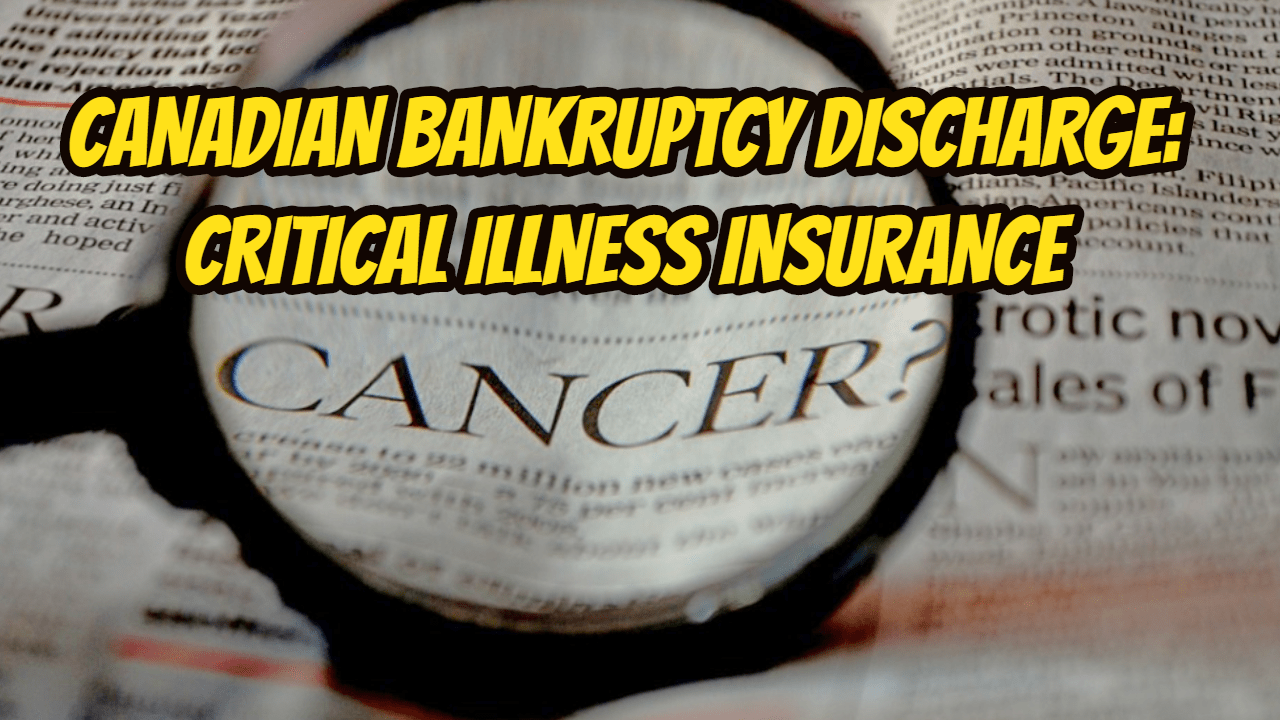Canadian bankruptcy discharge: Introduction
Many times during the administration of a Canadian bankruptcy, the licensed insolvency Trustee (formerly called a bankruptcy trustee) (Trustee) comes across a novel issue. The decision of A.R. Robertson, a Registrar in Bankruptcy in Calgary, Alberta in the bankruptcy discharge application of Shirley Rose Cooke has such an issue within it.
The case is Cooke (Re), 2018 ABQB 628 (CanLII). The issue that came before the Court was, what happens to a critical illness benefit payment for the undischarged bankrupt? Does it go to the Trustee or is the undischarged bankrupt debtor able to keep it? This topic should be of interest to accountants, lawyers, insurance agents and financial planners, in addition to Trustees.
Canadian bankruptcy discharge: The issue
Registrar Robertson described this case as an “interesting application” for bankruptcy discharge. The matter was heard on July 9, 2018. Ms. Cooke is 62 years old. She filed for bankruptcy on April 12, 2016. The issue to be decided is whether a critical illness benefit payment she obtained in the amount of $25,000, forms part of her assets which fall to the Trustee. The Trustee’s position was that it is an asset of the bankruptcy Estate and Ms. Cooke’s creditors are entitled to it.
Canadian bankruptcy discharge: The facts
In March 2016, Ms. Cooke was diagnosed with breast cancer. She went through surgery and had radiation treatments until July 2016. Prior to her medical diagnosis, she worked full time as a healthcare worker. She stopped working in March 2016 as a result of her diagnosis and need to undergo surgery and radiation. She returned to part-time work at her former employer, in about August 2016.
Her evidence was that at the time that she left her full-time work, her employer informed her she had the critical illness benefit policy and that she should apply under it. Apparently, she was unaware of this policy as being part of her benefits package. She applied for the benefit payment.
When she made her assignment in bankruptcy, she did not divulge the critical illness benefit application to the Trustee. She advised the Court that she did not have any type of certainty that she would receive the benefit. Eventually, she did, in January 2017. When she did, she advised her Trustee.
Canadian bankruptcy discharge: The Trustee’s position
The Trustee took the view that the critical illness benefit payment was a component of the insolvent person’s income under s. 67 of the Bankruptcy and Insolvency Act (R.S.C., 1985, c. B-3) (BIA). S. 67 of the BIA deals with property of the bankrupt, while s. 68 of the BIA deals with surplus income. However, s. 67 of the BIA does cover certain exclusions of types of payments a bankrupt may receive. The kinds of payments carved out are normally government type payments that have an overarching social aim, such as GST/HST tax credit payments.
It was very clear from the evidence that had she known she was going to get a $25,000 insurance payment from the insurance company, she would likely not have entered bankruptcy. Had she divulged the benefit application to the Trustee, the Trustee may very well have recommended she not go bankrupt.
The Trustee desires that Ms. Cooke pay the amount of $20,000 as a condition of her discharge. The Trustee states that in dealing with this critical illness benefit issue, including research, its fee now approximates that amount. I find it interesting that the Trustee is requesting the majority of her critical illness benefit payment as a discharge condition.
If the Trustee truly believes that the benefit payment should be considered as income under s. 67 of the BIA, then the correct treatment would be for the Trustee to redo its surplus income calculation under s. 68 of the BIA for Ms. Cooke. Then see what her surplus income obligation would be. If the Trustee is really trying to say the benefit payment is an asset that should come to the Trustee, then they should be asking for the entire $25,000. From my reading of the Registrar’s decision, it appears that the Trustee did neither but merely is asking for an amount to cover its costs!
Canadian bankruptcy discharge: The Registrar’s analysis
The Registrar indicated that in order to determine what is the appropriate condition if anything, he would have to assess the fees charged by the Trustee. If the Registrar really meant that he would have to tax the Trustee’s fee and costs, that makes sense. Otherwise, I am not sure what the connection is between the Trustee’s fee and costs, and whether a conditional discharge should be granted.
Ms. Cooke’s legal counsel referred to the Registrar the facts under s.173 of the BIA that could lead to an absolute discharge from bankruptcy not being granted. Her legal counsel indicated that none of the factors that would allow for a conditional, suspended or refused discharge apply in this matter.
The Registrar encouraged both parties to provide him with whatever additional information or authorities they thought appropriate by Tuesday, August 7, 2018.
The Trustee provided the Court with additional material. One such item was a copy of a letter sent by the Trustee to Ms. Cooke advising that, in the Trustee’s view, the critical illness benefit is a survivor benefit and not a wage or wage substitute. So much for it being part of surplus income!
The Registrar correctly pointed out that none of the exemptions in s. 67 of the BIA mention a critical illness benefit payment. The Registrar could also not find a precedent exactly on point.
The closest cases the Registrar could find were those of when the undischarged bankrupt suffered an injury in a motor vehicle accident and had a claim for pain and suffering. In that case, the action is personal to the injured person, and therefore that claim does not fall under the definition of property of the bankrupt available to the Trustee.
The Registrar stated that he sees no sensible distinction why a tort-based damages insurance claim for pain and suffering would be dealt with in a different way than a contract-based insurance policy for the pain and suffering Ms. Cooke had from her illness.
Accordingly, the Registrar decided that the critical illness benefit payment did not create a component of property designated to the Trustee. He also stated that Ms. Cooke did not have to pay any amount, to the Trustee. The Registrar went on to say that the Trustee should have brought on an application to have this matter determined much earlier in the bankruptcy proceedings so that the Trustee would not have incurred as many costs as it had.
The Registrar directed that:
- Although the Registrar did not explicitly state it in his judgment, the implication certainly is that Ms. Cooke received an absolute discharge from bankruptcy.
- Moreover, the Trustee should bring on the application for the Trustee’s discharge.
- Similarly, the Trustee should keep the Registrar’s comments as to the Trustee should have brought on a motion on the critical illness benefit issue earlier when submitting its dockets to have its fee and costs taxed by the Court.
Canadian bankruptcy discharge: Do you have too much debt?
I hope that none of us ever suffer from such a critical illness. However, it is good that Ms. Cooke had that insurance coverage. Do you have too much debt, or debt that you can’t repay because life got in your way? Illness and job loss are two prime factors in reducing someone’s income and increasing their expenses. It could force people to have to live off of credit cards until there is no credit room left, and no ability to ever repay the debt.
If you have too much debt, contact the Ira Smith Team. We have years of experience in helping those people and companies where life got in the way. Perhaps you need a debt settlement plan. Alternatively, if bankruptcy is the only real answer, we can help ease the stress and pain of bankruptcy for you.
Our approach for each file is to create an end result where Starting Over, Starting Now takes place. This starts the minute you are at our door. You’re simply one phone call away from taking the necessary steps to get back to leading a healthy, balanced hassle-free life. Call us today for your free consultation.


